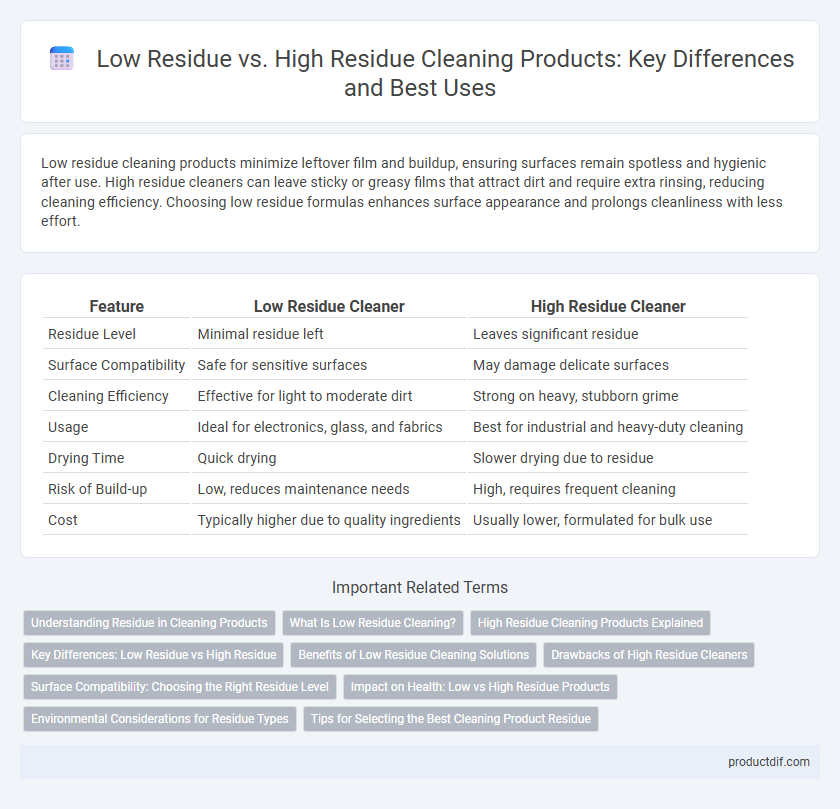Low residue cleaning products minimize leftover film and buildup, ensuring surfaces remain spotless and hygienic after use. High residue cleaners can leave sticky or greasy films that attract dirt and require extra rinsing, reducing cleaning efficiency. Choosing low residue formulas enhances surface appearance and prolongs cleanliness with less effort.
Table of Comparison
| Feature | Low Residue Cleaner | High Residue Cleaner |
|---|---|---|
| Residue Level | Minimal residue left | Leaves significant residue |
| Surface Compatibility | Safe for sensitive surfaces | May damage delicate surfaces |
| Cleaning Efficiency | Effective for light to moderate dirt | Strong on heavy, stubborn grime |
| Usage | Ideal for electronics, glass, and fabrics | Best for industrial and heavy-duty cleaning |
| Drying Time | Quick drying | Slower drying due to residue |
| Risk of Build-up | Low, reduces maintenance needs | High, requires frequent cleaning |
| Cost | Typically higher due to quality ingredients | Usually lower, formulated for bulk use |
Understanding Residue in Cleaning Products
Residue in cleaning products refers to the leftover substance that remains on surfaces after cleaning, impacting cleanliness and surface appearance. Low residue cleaners minimize the amount of leftover material, reducing risks of buildup, streaks, and damage, making them ideal for delicate surfaces such as glass and electronics. High residue products often contain heavier oils or polymers, which can offer protective barriers but may require additional rinsing to avoid sticky or film-like layers on surfaces.
What Is Low Residue Cleaning?
Low residue cleaning refers to the use of cleaning products formulated to leave minimal or no leftover substances on surfaces, reducing the risk of buildup and contamination. These products are especially important in environments like laboratories, food processing, and electronics manufacturing, where surface purity is critical. Low residue cleaners enhance hygiene standards and improve the longevity and functionality of sensitive equipment by preventing residue accumulation.
High Residue Cleaning Products Explained
High residue cleaning products often contain strong surfactants and detergents that leave behind sticky films or residues on surfaces, which can attract dirt and require additional rinsing. These products are typically more effective at breaking down tough grease and grime but may necessitate careful application to avoid buildup and damage to sensitive materials. Selecting a high residue cleaner depends on the cleaning requirements and surface type to balance effective soil removal with manageable cleanup.
Key Differences: Low Residue vs High Residue
Low residue cleaning products leave minimal traces after use, ensuring surfaces remain clean without buildup, which is essential for sensitive environments like electronics or medical facilities. High residue cleaners often contain heavier oils or surfactants that can leave a film, making them ideal for deep cleaning or heavy-duty grime removal but requiring more thorough rinsing. Choosing between low and high residue depends on the cleaning surface and desired finish, with low residue favored for delicate or precision cleaning and high residue suited for robust contaminant breakdown.
Benefits of Low Residue Cleaning Solutions
Low residue cleaning solutions leave behind minimal particles, preventing buildup that can attract dirt and cause surface damage over time. These products enhance the longevity of surfaces by maintaining their original finish and reducing the frequency of deep cleaning cycles. Using low residue cleaners supports healthier indoor environments by minimizing allergens and irritants commonly trapped in high residue residues.
Drawbacks of High Residue Cleaners
High residue cleaners leave behind sticky films that attract dirt and bacteria, reducing surface cleanliness and hygiene. These residues can cause buildup on surfaces, leading to frequent re-cleaning and increased maintenance costs. Additionally, high residue products may damage sensitive materials and diminish the effectiveness of subsequent cleaning processes.
Surface Compatibility: Choosing the Right Residue Level
Low residue cleaning products minimize the risk of damage and buildup on delicate surfaces such as glass, electronics, and painted finishes, ensuring longevity and visual clarity. High residue cleaners may be more effective for heavy-duty grime but can leave behind film or streaks that require additional rinsing to prevent surface degradation. Selecting the appropriate residue level based on the surface material improves cleaning efficiency while protecting surface integrity.
Impact on Health: Low vs High Residue Products
Low residue cleaning products minimize chemical buildup on surfaces, reducing exposure to allergens and skin irritants, which benefits respiratory and dermatological health. High residue products leave film or deposits that can harbor bacteria, increase allergy risks, and exacerbate asthma symptoms by trapping dust and allergens. Choosing low residue formulas supports a healthier indoor environment by limiting toxic buildup and promoting safer air quality.
Environmental Considerations for Residue Types
Low residue cleaning products minimize environmental impact by reducing chemical buildup in wastewater and preventing soil contamination, promoting safer ecosystems. High residue products often contain persistent chemicals that accumulate in water systems, harming aquatic life and disrupting natural biological processes. Choosing biodegradable, low residue formulations supports sustainable cleaning practices and aligns with eco-friendly waste management protocols.
Tips for Selecting the Best Cleaning Product Residue
Choosing a cleaning product with low residue is essential for surfaces prone to buildup, ensuring a streak-free, spotless finish. High residue products might provide intense cleaning power but often leave behind films that attract dirt and require frequent reapplication. Select cleaners with biodegradable, non-toxic ingredients and always test a small area to evaluate residue levels and surface compatibility before full use.
Low residue vs High residue Infographic

 productdif.com
productdif.com